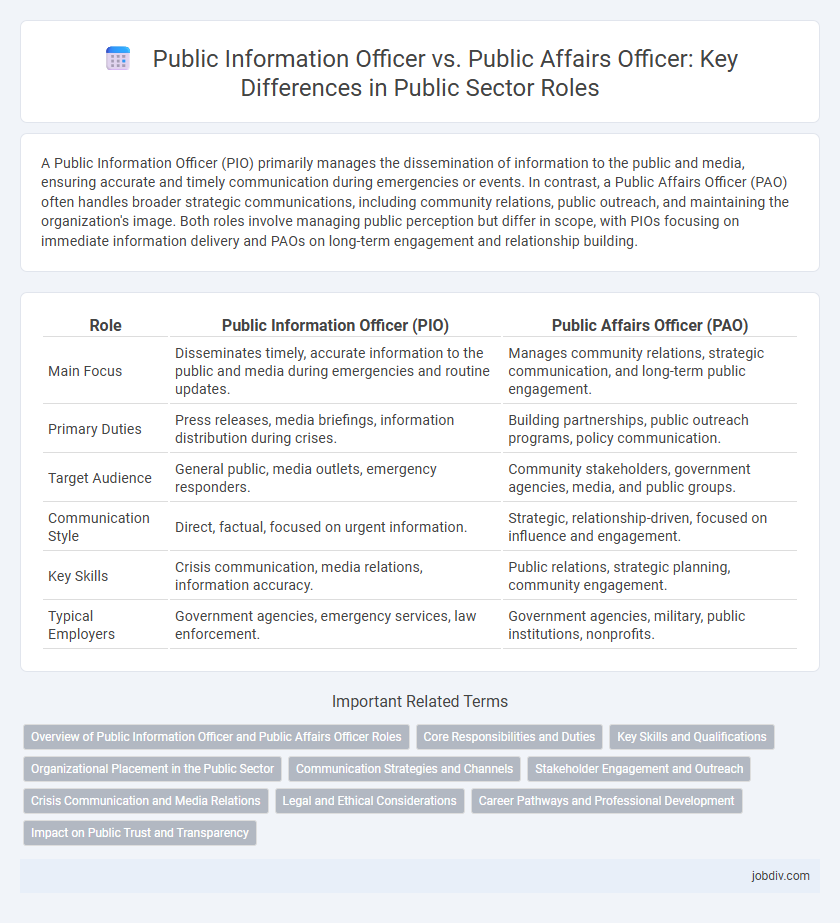A Public Information Officer (PIO) primarily manages the dissemination of information to the public and media, ensuring accurate and timely communication during emergencies or events. In contrast, a Public Affairs Officer (PAO) often handles broader strategic communications, including community relations, public outreach, and maintaining the organization's image. Both roles involve managing public perception but differ in scope, with PIOs focusing on immediate information delivery and PAOs on long-term engagement and relationship building.
Table of Comparison
| Role | Public Information Officer (PIO) | Public Affairs Officer (PAO) |
|---|---|---|
| Main Focus | Disseminates timely, accurate information to the public and media during emergencies and routine updates. | Manages community relations, strategic communication, and long-term public engagement. |
| Primary Duties | Press releases, media briefings, information distribution during crises. | Building partnerships, public outreach programs, policy communication. |
| Target Audience | General public, media outlets, emergency responders. | Community stakeholders, government agencies, media, and public groups. |
| Communication Style | Direct, factual, focused on urgent information. | Strategic, relationship-driven, focused on influence and engagement. |
| Key Skills | Crisis communication, media relations, information accuracy. | Public relations, strategic planning, community engagement. |
| Typical Employers | Government agencies, emergency services, law enforcement. | Government agencies, military, public institutions, nonprofits. |
Overview of Public Information Officer and Public Affairs Officer Roles
Public Information Officers (PIOs) primarily manage the dissemination of timely, accurate information to the public and media during emergencies or routine operations, acting as official spokespersons for government agencies or organizations. Public Affairs Officers (PAOs) coordinate communication strategies that promote positive community relations and manage public engagement efforts, often focusing on long-term messaging and reputation management. Both roles require expertise in media relations, crisis communication, and message development, but PIOs emphasize real-time information distribution while PAOs concentrate on strategic public outreach.
Core Responsibilities and Duties
A Public Information Officer (PIO) primarily manages the dissemination of accurate and timely information to the public and media, ensuring transparency and clarity during emergencies or routine operations. The Public Affairs Officer (PAO) focuses on fostering positive relationships between an organization and its various stakeholders, including the community, government entities, and partners, through strategic communication and outreach efforts. Both roles involve communication but differ as PIOs concentrate on information distribution and crisis communication, while PAOs emphasize stakeholder engagement and public relations.
Key Skills and Qualifications
Public Information Officers excel in media relations, crisis communication, and message development, requiring strong writing, public speaking, and social media management skills. Public Affairs Officers focus on government relations, community engagement, and policy analysis, demanding expertise in stakeholder coordination, strategic planning, and regulatory knowledge. Both roles benefit from critical thinking, adaptability, and proficiency in communication technology to effectively manage public perception and information dissemination.
Organizational Placement in the Public Sector
Public Information Officers typically operate within government communication departments or municipal offices, directly managing information dissemination to the public and media. Public Affairs Officers are often embedded within specific agencies or military units, focusing on strategic communication and stakeholder engagement to support organizational missions. Both roles are crucial in ensuring transparent and effective communication but differ in their placement and scope within the public sector hierarchy.
Communication Strategies and Channels
Public Information Officers (PIOs) primarily utilize traditional media channels such as press releases, public service announcements, and social media platforms to disseminate timely and factual information to the public. Public Affairs Officers (PAOs) implement targeted communication strategies that emphasize stakeholder engagement, community outreach, and internal communication within government or military organizations. Both roles optimize digital tools and analytics to measure message effectiveness and enhance public trust through transparency and consistent information flow.
Stakeholder Engagement and Outreach
Public Information Officers (PIOs) specialize in delivering accurate and timely information to the public and media, ensuring transparency and clarity during crises or routine communications. Public Affairs Officers (PAOs) focus on building and maintaining long-term relationships with diverse stakeholders, including community groups, government entities, and the public, to support organizational goals through strategic engagement and outreach programs. Both roles collaborate to optimize messaging and enhance public trust, with PIOs managing information dissemination and PAOs driving proactive stakeholder involvement.
Crisis Communication and Media Relations
Public Information Officers (PIOs) specialize in disseminating accurate, timely information during crises to manage public perception and ensure transparency, serving as the primary liaison to the media and the public. Public Affairs Officers (PAOs) focus on strategic communication efforts, including media relations and community engagement, to shape public opinion and support organizational goals, particularly during emergencies. Both roles require expertise in crisis communication, but PIOs emphasize immediate information release, while PAOs develop broader communication strategies.
Legal and Ethical Considerations
A Public Information Officer (PIO) must adhere strictly to legal guidelines on transparency and confidentiality while ensuring timely and accurate dissemination of public information. In contrast, a Public Affairs Officer (PAO) balances strategic communication with ethical obligations to maintain public trust and support policy initiatives. Both roles require compliance with laws such as the Freedom of Information Act and ethical standards to prevent misinformation and protect sensitive data.
Career Pathways and Professional Development
Public Information Officers typically focus on managing media relations, crafting official statements, and disseminating timely information to the public, often requiring expertise in journalism or communications. Public Affairs Officers engage broader strategic communication initiatives, including community outreach, government relations, and crisis communication, with career progression often involving advanced training in public administration or policy analysis. Professional development for both roles emphasizes ongoing skills in digital media, strategic messaging, and stakeholder engagement to enhance public trust and information accuracy.
Impact on Public Trust and Transparency
Public Information Officers (PIOs) directly enhance transparency by providing timely, accurate updates during crises, fostering public trust through clear communication. Public Affairs Officers (PAOs) shape public perception by managing community relations and strategic messaging, indirectly influencing trust through engagement and advocacy. Both roles are crucial for maintaining transparency, but PIOs impact real-time information flow while PAOs focus on long-term trust-building.
Public Information Officer vs Public Affairs Officer Infographic

 jobdiv.com
jobdiv.com